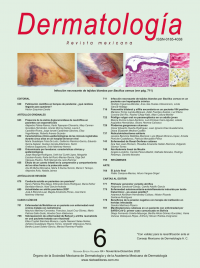Clinical-epidemiological characteristics of mycoses registered during five years in a third level hospital.
Dermatol Rev Mex. 2020; 64 (6): 650-657.
María Guadalupe Frías-De León,1 Guillermo Ramírez-García,1 Eduardo García-Salazar,2 Gustavo Acosta-Altamirano,1 Kerim Orellana-Sagastume,3 Erick Martínez-Herrera1
1 Unidad de Investigación, Hospital Regional de Alta Especialidad de Ixtapaluca, Estado de México.
2 Maestría en Ciencias de la Salud, Escuela Superior de Medicina, Instituto Politécnico Nacional, Ciudad de México.
3 Facultad de Medicina, Centro Universitario de Oriente (CUNORI), Chiquimula, Universidad de San Carlos de Guatemala, Guatemala.
Resumen
ANTECEDENTES: La incidencia y prevalencia de las micosis cambia constantemente dependiendo del área geográfica, sexo, edad, clima y localización de la lesión, por lo que comprender su epidemiología no es fácil porque las infecciones por hongos no son de reporte obligatorio, lo que conlleva al desconocimiento de su frecuencia real.
OBJETIVO: Conocer la situación epidemiológica de las micosis en un hospital de tercer nivel en el Estado de México en el periodo 2013-2018.
MATERIAL Y MÉTODO: Estudio retrospectivo, observacional y transversal efectuado en un hospital de tercer nivel del Estado de México. La muestra de estudio la constituyeron los expedientes de pacientes con diagnóstico de micosis de 2013 a 2018. Las variables analizadas fueron: tipo de micosis, agente etiológico, sexo, edad, comorbilidades y tratamiento.
RESULTADOS: Se encontraron 671 casos de micosis que afectaba a hombres y mujeres de 0 a 85 años. La frecuencia de los tipos de micosis fue: 62.6% oportunistas, 36.4% superficiales, 0.7% sistémicas y 0.3% subcutáneas. La comorbilidad más frecuente fue la diabetes mellitus. En el tratamiento de elección se incluyeron los antifúngicos azólicos o poliénicos.
CONCLUSIONES: Los datos epidemiológicos obtenidos en este estudio revelan que las micosis oportunistas son las más frecuentes y que la población más afectada es la que cursa con diabetes mellitus. Por ello, es necesario implementar programas de prevención, ya que algunas micosis, como la mucormicosis, son potencialmente mortales.
PALABRAS CLAVE: Candidiasis; mucormicosis; diabetes mellitus.
Abstract
BACKGROUND: The incidence and prevalence of fungal infections constantly changes depending on the geographical area, sex, age, climate and location of the lesion, so understanding its epidemiology is not easy because fungal infections are not mandatory reporting, leading to the ignorance of its real frequency.
OBJECTIVE: To know the epidemiological situation of mycoses in a third level hospital in the State of Mexico in the period 2013-2018.
MATERIAL AND METHOD: A retrospective, observational and cross-sectional study was carried out in a third level hospital in the State of Mexico, Mexico. The study sample was constituted by the records of patients with a diagnosis of mycosis from 2013 to 2018. The variables analyzed were: type of mycosis, etiological agent, sex, age, comorbidities and treatment.
RESULTS: 671 cases of mycosis were found, affecting men and women aged 0-85 years. The frequency of the types of mycoses were: 62.6% opportunistic, 36.4% superficial, 0.7% systemic and 0.3% subcutaneous. The most frequent comorbidity was diabetes mellitus. The azole or polyene antifungals were the treatment of choice.
CONCLUSIONS: The epidemiological data obtained in this study reveal that opportunistic mycoses are the most frequent and that the most affected population is the one with diabetes mellitus. Therefore, it is necessary to implement prevention programs, since some mycoses, such as mucormycosis, are life-threatening.
KEYWORDS: Candidiasis; Mucormycosis; Diabetes mellitus.

